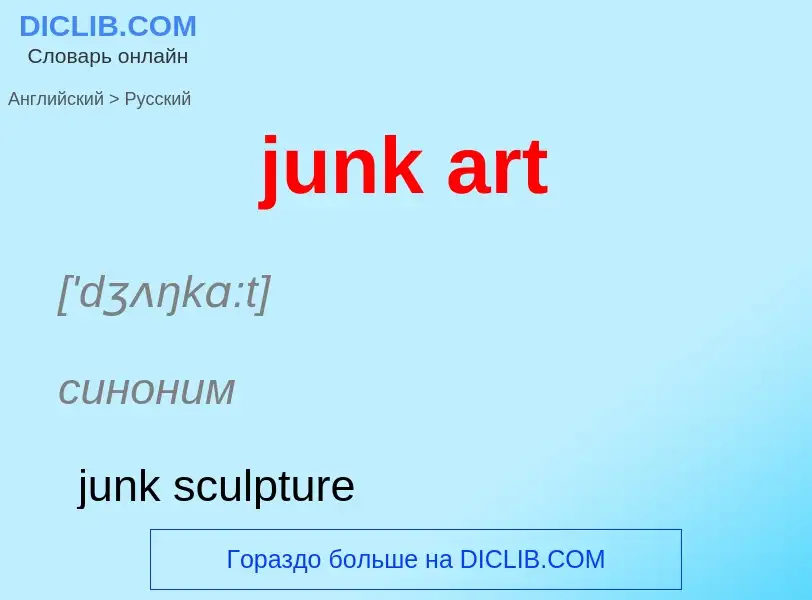Μετάφραση και ανάλυση λέξεων από την τεχνητή νοημοσύνη ChatGPT
Σε αυτήν τη σελίδα μπορείτε να λάβετε μια λεπτομερή ανάλυση μιας λέξης ή μιας φράσης, η οποία δημιουργήθηκε χρησιμοποιώντας το ChatGPT, την καλύτερη τεχνολογία τεχνητής νοημοσύνης μέχρι σήμερα:
- πώς χρησιμοποιείται η λέξη
- συχνότητα χρήσης
- χρησιμοποιείται πιο συχνά στον προφορικό ή γραπτό λόγο
- επιλογές μετάφρασης λέξεων
- παραδείγματα χρήσης (πολλές φράσεις με μετάφραση)
- ετυμολογία
junk art - translation to Αγγλικά
['dʒʌŋkɑ:t]
синоним
[ɔbʒei'tru:vei]
Франция
находка
диковина
открытие (о предметах искусства)
['faund'ɔbdʒekt]
общая лексика
дар природы
предмет искусства
созданный самой природой (причудливая ветка, обточенный; морем кусок дерева и т. п.)
Βικιπαίδεια

A found object (a loan translation from the French objet trouvé), or found art, is art created from undisguised, but often modified, items or products that are not normally considered materials from which art is made, often because they already have a non-art function. Pablo Picasso first publicly utilized the idea when he pasted a printed image of chair caning onto his painting titled Still Life with Chair Caning (1912). Marcel Duchamp is thought to have perfected the concept several years later when he made a series of ready-mades, consisting of completely unaltered everyday objects selected by Duchamp and designated as art. The most famous example is Fountain (1917), a standard urinal purchased from a hardware store and displayed on a pedestal, resting on its side. In its strictest sense the term "ready-made" is applied exclusively to works produced by Marcel Duchamp, who borrowed the term from the clothing industry (French: prêt-à-porter, lit. 'ready-to-wear') while living in New York, and especially to works dating from 1913 to 1921.
Found objects derive their identity as art from the designation placed upon them by the artist and from the social history that comes with the object. This may be indicated by either its anonymous wear and tear (as in collages of Kurt Schwitters) or by its recognizability as a consumer icon (as in the sculptures of Haim Steinbach). The context into which it is placed is also a highly relevant factor. The idea of dignifying commonplace objects in this way was originally a shocking challenge to the accepted distinction between what was considered art as opposed to not art. Although it may now be accepted in the art world as a viable practice, it continues to arouse questioning, as with the Tate Gallery's Turner Prize exhibition of Tracey Emin's My Bed, which consisted literally of a transposition of her unmade and disheveled bed, surrounded by shed clothing and other bedroom detritus, directly from her bedroom to the Tate. In this sense the artist gives the audience time and a stage to contemplate an object. As such, found objects can prompt philosophical reflection in the observer ranging from disgust to indifference to nostalgia to empathy.
As an art form, found objects tend to include the artist's output—at the very least an idea about it, i.e. the artist's designation of the object as art—which is nearly always reinforced with a title. There is usually some degree of modification of the found object, although not always to the extent that it cannot be recognized, as is the case with ready-mades. Recent critical theory, however, would argue that the mere designation and relocation of any object, ready-mades included, constitutes a modification of the object because it changes our perception of its utility, its lifespan, or its status.



![''[[An Oak Tree]]'' by [[Michael Craig-Martin]]; 1973 ''[[An Oak Tree]]'' by [[Michael Craig-Martin]]; 1973](https://commons.wikimedia.org/wiki/Special:FilePath/An Oak Tree (conceptual art installation).jpg?width=200)
![Junk art at [[Oak Street Beach]] Junk art at [[Oak Street Beach]]](https://commons.wikimedia.org/wiki/Special:FilePath/Beachjunkart.jpg?width=200)
![Art made from trash found on the streets of New York City by artist [[Bobby Puleo]] (2021) Art made from trash found on the streets of New York City by artist [[Bobby Puleo]] (2021)](https://commons.wikimedia.org/wiki/Special:FilePath/Bobby Puleo art 2 26 2021.jpg?width=200)
![Highway 66]] near [[Amboy, California]] Highway 66]] near [[Amboy, California]]](https://commons.wikimedia.org/wiki/Special:FilePath/Tennisshoes.jpg?width=200)
